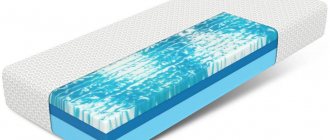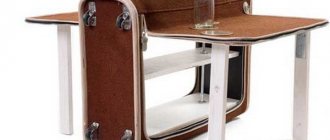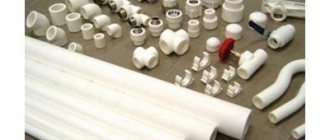Is it possible to use plastic pipes for heating?
Plastic quickly loses technical characteristics when exposed to high temperatures. Therefore, when choosing plastic pipes for heating, you need to select products that meet a number of requirements:
- The plastic must be able to withstand the temperature of the coolant. The maximum temperature is 95 degrees. At this temperature, the pipes should not be deformed.
- The pipes must withstand high pressure so that water hammer occurring in the system cannot destroy the pipeline.
- Minimum coefficient of thermal expansion. Otherwise, individual elements of the pipeline will sag when heated. When temperatures drop, internal stresses may occur, which negatively affect the strength of the tubes.
- The pipes must be straight from the inside. If this requirement is not taken into account, plaque will accumulate on the inner walls, which will lead to blockages.
- Pipeline elements should not be destroyed when exposed to various chemicals that may be contained in tap water.
- The individual elements from which the heating circuit is assembled must be durable in order to function for a long time without breakdowns.
- The pipes must have a high level of sound insulation so that the flow of water cannot be heard in the rooms.
Plastic pipes meet all the necessary requirements, but they have one serious drawback - a high coefficient of thermal expansion. Because of this, long tubes can sag when heated. To prevent this, you need to install special compensators. They minimize the risk of tube deformation during thermal expansion and increase the strength of pipeline joints.
Scope of application of plastic pipes for water supply
When choosing a plastic pipe, you need to take into account its characteristics and operating temperature range
Polymer pipes are used not only for arranging water supply systems - external or internal. They are used for transporting gases and chemically aggressive substances. Plastic is a neutral substance. It does not react with acids or alkalis. The products are used for laying sewers, since the inner surface of the pipes does not promote the proliferation of pathogenic bacteria - microorganisms cannot form colonies.
Depending on the technical characteristics, polymer materials are used in hot and cold water supply systems. You just need to choose the right pipes so that the operating temperature range matches the capabilities of the plastic.
There are especially strong polymers that are used in very low temperatures. They are suitable for the construction of autonomous water supply and sewerage systems in the far north, where the level of soil freezing is about 2.5 m. It is important to take this indicator into account, since there is always a certain amount of water in the soil. Turning into ice, such a liquid is capable of deforming the main line if it does not have a safety margin, so the pipes are laid either to a greater depth or other materials are selected.
Plastic pipes are used for casing wells of any depth, even artesian ones, the depth of which is about 300 m. For summer residents and greenhouse owners, polymers are a cheap solution for organizing irrigation in the summer. It is known that plastic does not withstand direct sunlight and quickly loses its quality, but its cost is not so high that you need to worry about replacement.
To replace and strengthen old steel water pipes, use the method of internally inserting a plastic pipe after first cleaning the old one. Thus, the liquid begins to flow over the new plastic and the water becomes cleaner.
Characteristics
Technical characteristics determine the scope of application of the products. The manufacturer indicates them on the packaging of the pipes or on the plastic surfaces themselves. Options:
- the material from which the parts are made;
- diameter of plastic pipes;
- maximum coolant temperature;
- the maximum pressure that the pipe can withstand;
- sizes of plastic pipes for heating.
To indicate characteristics, a labeling system for products made from different types of plastic was developed.
Pipes for hot coolant
Markings and technical specifications
Each product has a marking that contains the necessary information for the consumer: scope of application, dimensions, information about the manufacturer, etc.
Marking is a kind of technical passport in the form of an alphanumeric code, from which you can find out everything about the product.
We recommend that you familiarize yourself with: Sewer adapters for installing pipes made of different materials
Depending on the diameter, pipes are divided into small (from 10 to 50 mm), medium (from 50 to 225 mm), large (from 225 mm).
Marking
There are several types of plastic used to make pipelines:
- PVC pipes;
- polypropylene products;
- polyethylene parts.
A separate group includes tubes, during the manufacture of which a reinforcing layer of aluminum foil or fiberglass is placed between layers of plastic.
The marking varies depending on the type of polymer. There is no point in describing the designations on PVC, since this material is not used for the manufacture of water supply and heating pipelines. This type of polymer releases harmful substances when heated and has low performance characteristics.
Polyethylene marking:
- PE 32 is a type of polyethylene with the lowest density. It is rarely used for making pipes.
- PE 63 - used for assembling non-pressure systems. This could be sewer drains, an outdoor shower. This type of polyethylene cannot withstand high pressure and is destroyed by water hammer.
- PE 80 is a type of polyethylene with a high strength index. Used for assembling cold water supply systems. If the pipeline is laid outside buildings, additional insulation must be used.
- PE 100 - pipes made from this type of polyethylene have the highest strength index. They are used for the manufacture of industrial pipelines, hot and cold water supply systems, heating circuits.
The marking of polyethylene tubes contains the abbreviation SDR, followed by numbers. The lower this indicator, the stronger the product.
Marking of polypropylene tubes:
- PN10. Products with this designation can withstand pressure up to 1 MPa. The permissible liquid temperature is 45 degrees Celsius. Due to their low strength and heat resistance, such tubes are used for assembling sewage drains and cold water supply pipelines.
- PN16. The maximum permissible pressure level is 1.5 MPa. The coolant temperature should not exceed 60 degrees. Popular for the manufacture of cold water supply systems. Rarely used for assembling hot water circuits.
- PN20. Tubes made of this type of polypropylene can withstand pressure up to 2 MPa. The maximum permissible coolant temperature is 80 degrees. Used for assembling hot and cold water supply systems, heating circuits.
- PN25 is the most durable type of polypropylene. This material can withstand pressure up to 2.5 MPa. The coolant temperature can rise to 95 degrees. Withstands temperature surges - up to 110 degrees.
Marking of multilayer products:
- PPR - the outer layer of the tubes is covered with polypropylene;
- AL - has a reinforcing layer of aluminum foil;
- PP-RCT is a designation for modified polypropylene, which has increased thermostatic properties.
If there is a layer of fiberglass inside the pipe, the marking will contain the letters FG, FR.
Heating pipes made of polypropylene
What is special about PVC pipes
PVC - polyvinyl chloride pipes are made from a synthetic polymer that is highly resistant to chemical attack.
When transporting water, not only the strength of the system is important, but also its safety. Toxic materials are not used in the production of polymer pipes, so they do not have a specific odor. Due to its inertness to various chemical compounds and non-toxicity, polyvinyl chloride is an ideal option for transporting drinking water. However, the material can be compared to cast iron; it is a kind of analogue, only in the world of polymers. Therefore, it is mainly used in sewer systems and water mains with low pressure.
Advantages of PVC pipe products
The choice of PVC pipes is rational and completely justified. PVC pipe fittings have technical characteristics that allow them to be preferred when installing water mains.
- In practice, the products have shown their resistance to the growth of mold and bacteria; the appearance of deposits on their internal walls is excluded, so they can be used for transporting drinking water without fear for its quality.
- PVC pipes are easy to install and look aesthetically pleasing. They can simply be glued together by applying a special compound to the pipe cut and the connecting piece.
- They have good throughput and low weight.
- Do not support fire. It is enough to eliminate the source for the combustion to stop.
- The undoubted advantage of this type of pipes is that they do not oxidize and do not rust.
- PVC pipes are characterized by low cost and long service life, while they are easy to transport and install. With proper installation and operation they are designed to last 40-50 years.
We recommend that you read: Scissors for cutting propylene pipes - types and technology of application
Flaws
The main requirement for water pipes is their ability to withstand loads associated with significant pressure in the system. PVC pipes have the ability to withstand relatively low hydraulic loads of 6-16 bar.
PVC pipes have insufficient ductility, so they are not recommended for use in pressure systems where the working environment is under significantly greater pressure than they can withstand.
PVC pipes are not used in hot water supply because they can withstand temperatures of no more than +45°C.
In addition, the product weakly resists mechanical loads. Not resistant to UV rays.
A significant disadvantage is the difficulty of disposing of the product; they do not rot, do not decompose, and cannot be burned, since chlorine is released during the combustion process.
Note! It is important to note that the development of technologies and the improvement of products used for plumbing systems has advanced greatly in recent years, and today, along with conventional PVC pipes, varieties are used: uPVC, which can work in pressure systems, and CPVC for hot water supply systems.
The use of PVC pipes in engineering pressure systems became possible with the creation of a variety of uPVC; this pipe is made from unplasticized polyvinyl chloride, i.e. from a polymer that does not contain plasticizers, has greater strength and is used in both free-flow and pressure cold water supply systems.
For the installation of hot water supply systems, CPVC pipes are used - a type of PVC pipe reinforced with chlorine content. The products interact well with hot water. These pipes appeared about half a century ago in the USA; they began to be used in Russia in the last decade.
Varieties
You can find different types of plastic pipes that are used to make pipelines. Types of pipes used for assembling heating circuits:
- Polypropylene. A material that is most often used in the manufacture of pipelines for heating, cold and hot water supply. This is due to the many advantages of this material and low price.
- Cross-linked polyethylene. Tubes made of this material are more expensive than polypropylene. Suitable for installation indoors and outdoors. Withstands temperatures from -50 to 100 degrees. Destroyed by prolonged exposure to ultraviolet rays. Because of this, they need to be mounted in protective housings.
- Metal-plastic products. Such tubes are often used in the manufacture of pipelines. The parts consist of several layers - an outer and an inner layer of polyethylene. Between them there is aluminum foil.
The choice of material depends on the operating conditions and required technical characteristics.
Cost of plastic pipes
The cost of plastic products is formed from many indicators - the amount of material consumed and its quality, the distance to which the pipes are delivered. The type of material also matters. For example, the price of PVC pipes for hot water supply will be higher than polyethylene pipes with a smaller operating temperature range.
Products from an imported manufacturer, especially well-known brands, are always higher than the same quality of pipes from a little-known domestic manufacturer. It is recommended to consult with a manager before purchasing - you may not have to overpay for the brand.
Due to the popularity of plastic pipes in construction, there are many low-quality products on the market made from recycled materials that are unsuitable for drinking water mains. It is necessary to purchase materials for construction at trusted sales points.
Advantages and disadvantages
Advantages:
- Plastic pipes do not collapse when exposed to moisture for a long time.
- The material is environmentally friendly. It does not emit harmful substances when heated.
- Due to low thermal conductivity, water reaches the heat exchangers without cooling.
- The average service life under normal operating conditions without overload is 50 years.
- Thanks to the high sound insulation of the material, the sound of water flowing through the pipes is not heard in the rooms.
- Plastic parts are easy to transport and assemble together without the help of others.
- Plastic does not deform when exposed to chemicals that may be contained in pipeline water.
- Plastic tubes have smooth inner walls. Thanks to this, plaque does not accumulate on them.
Flaws:
- High coefficient of linear expansion. It must be taken into account when connecting individual pipeline elements.
- Low heat resistance. Therefore, when installing a pipeline outdoors, you need to use additional insulation.
- The material ages faster when exposed to ultraviolet rays.
If pipes are mounted on vertical surfaces, more fasteners must be used to prevent individual pipeline elements from sagging.
Easy pipe installation
Plastic profile pipes.
A technical plastic pipe does not have to be round in cross-section. So-called profile technical pipes can have different shapes. It can be a square, a triangle, a rectangle, or a rhombus. Manufacturers even sometimes have to make custom-made plastic HDPE profile pipes in the shape of a star.
Plastic profile pipes are made from low-density polyethylene (HDPE) using a special original nozzle for the extruder, and technologies and modern equipment make it possible to produce such products for kilometers.
Sizes and prices
Manufacturers produce pipes of different diameters; the outer thickness can be from 12 to 1000 mm. Length varies from 56 centimeters to 6 meters. Therefore, you need to take measurements and determine which size is right for you. When choosing a diameter, you need to take into account the place of use, for example, in a house the load on the pipe will be much less than in a school. If the pipe will be used at an industrial facility, its diameter should be about 300 mm. Schools, hospitals and other public places use PVC pipes with a diameter of 200 mm. For a home, the maximum size should be 150 mm, this will be more than enough.
People use square pipes only for irrigating their garden plots. Prices for PVC pipes depend on many factors, such as:
- manufacturer;
- diameter;
- length;
- for internal or external water supply.
Taking into account the average readings, the cost of the smallest pipe with a diameter of 56 centimeters is about 100 rubles. Medium pipes with a diameter of 100 - 150 millimeters and a length of 3 meters have a price of about 500 rubles per piece. The most expensive pipes, which are used in large industrial enterprises, cost more than 10 thousand rubles per 6 meters.
PVC pipes are widely used in all types of buildings. They may differ in diameter, length, thickness, manufacturer, but they have one thing in common - reliability. Such pipes will serve their owners for decades; various blockages do not form inside them, and they are not subject to corrosion.











